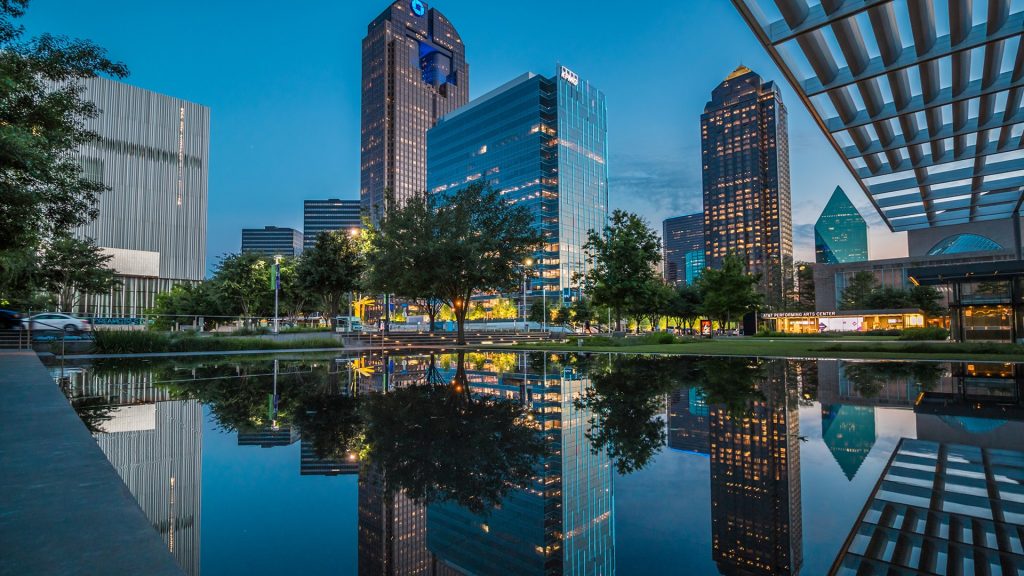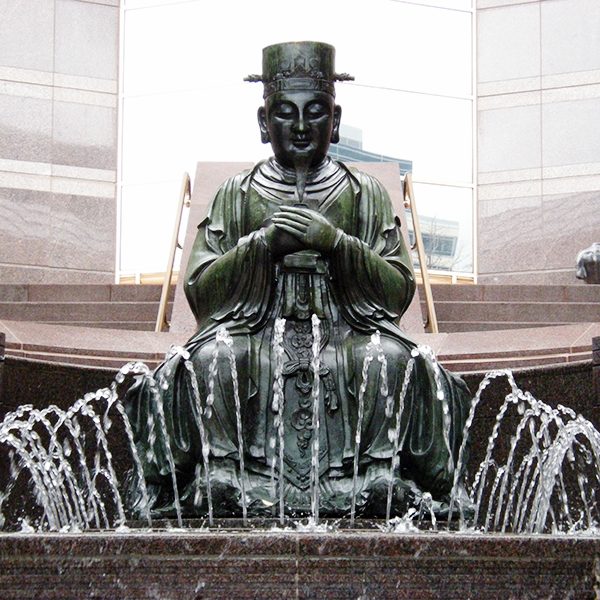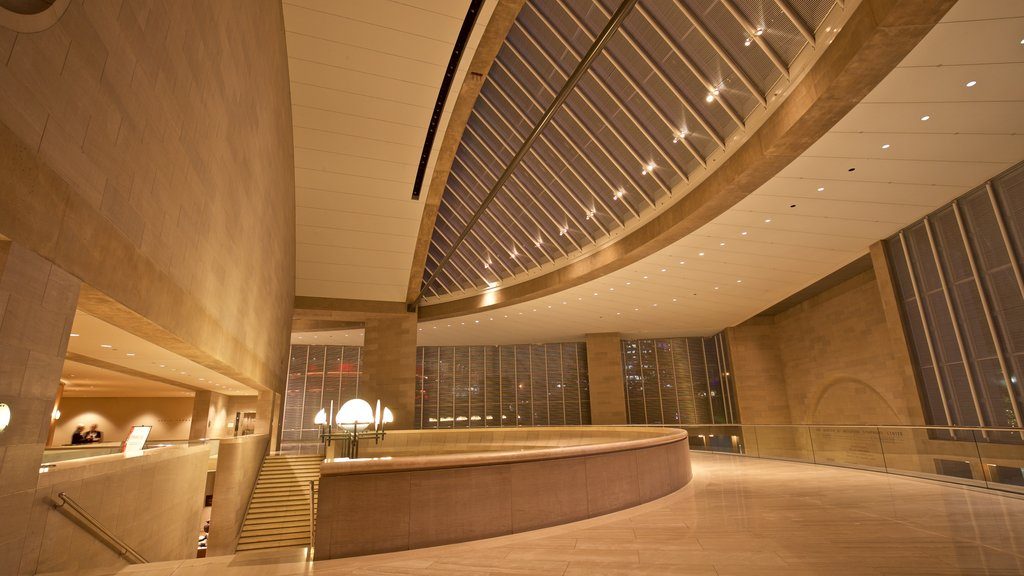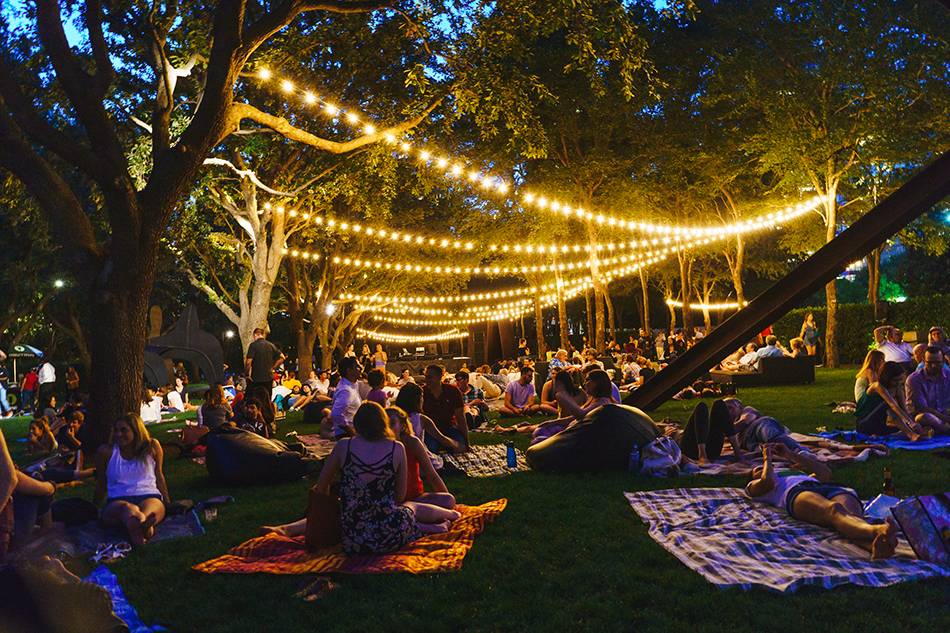Dallas Arts District

When you mention Dallas, sports fans think of the Cowboys, foodies think of barbecue, and history buffs and conspiracy theorists think of JFK’s assassination. But does anybody think of art? How about architecture? No? Well, keep on reading. On a business trip to Dallas, I stayed an extra day to seek out wonders existing right under my nose that I had been too busy working to explore. That’s when I discovered the Dallas Arts District and was totally blown away. Where else can you find world class museums, concert halls, and performing arts venues conveniently located on 19 contiguous city blocks spanning 68 acres? Nowhere. Dallas is the only place in the world where it exists.[1] And it gets better. On those 19 blocks, there are no less than 5 buildings designed by Pritzker award-winning architects.[2] Luckily, I had time to visit 2 of these architectural marvels because I went to the Arts District on a Friday when many of the museums offer extended hours. More about that later . . .
My first stop was the Crow Museum of Asian Art of The University of Texas at Dallas, an unexpected treasure trove in light of the fact that the Dallas- Fort Worth region does not have a sizeable Asian-American population (5.9% compared with 13% in New York City and 35.8% in San Francisco). Why the Crow? I’ve been fascinated by Asian art ever since I was a kid, captivated by the Zodiac signs on my Chinese restaurant placemat. Although the size of my wallet is considerably smaller, I can related to the museum’s founders, Trammel and Margaret Crow, who fell in love with Chinese art forms on their first visit to China in 1976 after the death of Mao Zedong when decades of icy relations with the U.S. were just beginning to thaw. Over the years, the Crows amassed a sizable collection of Chinese art and as their travels expanded, they added more pieces from Japan, India, and other Southeast Asian countries. With the expert assistance of Clarence Shangraw from the Asian Art Museum of San Francisco, they selected the pieces forming the core of the permanent collection and achieved their goal of “bridging the gap between East and West” when the museum opened its doors in 1998.
The Crow Museum defines Asia as “endlessly diverse, and not of one place, time, or idea.” Visitors are invited to explore these dual themes of infinity and timelessness, which cease to be abstract concepts when you’re eyeballing objects originating from a kaleidoscope of cultures that literally spans the centuries. For example, contemporary Japanese ceramics of all shapes, colors, and sizes were exhibited on the ground floor, meticulously carved jade sculptures from the Qing Dynasty (1644-1911) were exhibited on the upstairs level along with a mid-career retrospective of Master Shen-Long’s innovative ink paintings, and a Japanese bell from the Edo Period (1615-1868) hung silently in the courtyard, waiting in vain for a monk to come along and strike it with a wooden mallet. In honor of its 20th anniversary, the building underwent a multi-million dollar expansion in 2018,[3] which doubtlessly reinforced the Crow Museum’s nickname “the Jewel Box of the Dallas Arts District,” alluding to the fact that the true gems can be found within, not unlike the Three Jewels of Bhuddism.[4]

On to my second stop–the Morton H. Meyerson Symphony Center, aka “the Meyerson”–which opened in September 1989.[5] As you enter the lobby and pavilion, you walk along a curving pathway connected to other curving pathways constructed of what appears to be miles of Italian travertine (30,000 square feet as a matter of fact). A physically commanding experience that’s absolutely breathtaking, you feel like you’re inside a giant nautilus shell straight out of Jules Verne’s 20,000 Leagues Under the Sea, with all paths leading everyone to the central chamber where the Eugene McDermott Concert Hall is situated.[6] It’s worth noting that internationally renowned architect I.M. Pei who designed the Meyerson wasn’t thrilled with the concert hall’s shoebox design that had already been decided upon by the trustees, complaining that it was “too conservative” for him to fully express himself. This illustrates what I believe to be a universal truth–when a modicum of restraint is imposed upon an artist, the resulting work is more impressive. Like when you put a small gift in a large box to instill a sense of mystery and surprise, Pei was prompted to “wrap another form” around the shoebox, giving birth to the curvilinear shape that he later admitted “created excitement in that space.”[7]
Conservative or not, audiophiles will tell you there was good reason for the concert hall’s shoebox design. Celebrated acoustician Russell Johnson succeeded at his goal to create a acoustical masterpiece similar to the Vienna Musikverein and the Amsterdam Concertgebouw.[8] According to Jaap van Zwede, Dallas Symphony Orchestra Music Director: “The acoustics of this hall are comparable to the great concert halls of Europe, and of the world. The concert hall itself becomes an instrument of the orchestra, and we adjust to it and fine tune our music-making to the hall week after week.”[9] I stayed to watch the performance of resident master percussionists, D’Drum, and I can attest to the sonorous quality of the room; instead of all the vibrations rising up to the balcony like heat waves, it sounded like the musicians were down in the Orchestra Section with me, minus the unsettling reverberations that usually accompany the beating of drums and banging of gongs at close distance.[10]

While the Crow Museum was intimate and contemplative and the Meyerson was impressive and arresting, my 3rd stop–the Nasher Sculpture Center–was open and engaging.
The brainchild of Raymond & Patsy Nasher, “The Nasher” as it’s affectionately called by locals, is one of the first museums in the world exclusively dedicated to modern and contemporary sculpture. Interestingly, it was the Nashers’ travels to Mexico sparking their interest in pre-Columbian art that led to their lifelong love of modern sculpture–a profound example of how learning about the ancient past can produce a deeper appreciation of the present. Besides the popular rotating special exhibitions, the Nasher showcases more than 300 works by Giacometti, di Suvero, Matisse, Rodin, Picasso, Moore, Serra, Miró, Kelly, and other luminaries.[11]
Now, I’m not an expert in modern sculpture–far from it–but in my humble opinion, the building housing the Nasher collection and the adjoining sculpture garden are the real masterpieces. You don’t have to give a fig about sculpture to thoroughly enjoy being there. The immense 54,000 square foot building designed by architect Renzo Piano has an archeological aesthetic, like a classical ruin in an urban landscape, undoubtedly a homage to the Nashers’ early interest in antiquities. But the building’s design is scientific in a functional sense too; it utilizes the best features of the surrounding natural environment to help visitors see and appreciate the sculptures while neutralizing the harsh effects of the merciless Dallas sun. The ivory, low-reflective Italian travertine tiles provide lightness and minimize glare, the glass walls facing the street and garden connected by 500-foot long corridors provide unobstructed views and create the illusion that the sculptures are floating in mid-air, and the glass roof shielded by a sunscreen comprised of hundreds of cast aluminum shells that looks like a giant honeycomb is a miraculous feat of engineering–direct sunlight is kept out so that only the soft northern light can come in, making the forms and textures of the sculptures really pop.[12]
The 1.4 acre sculpture garden designed by California landscape architect Peter Walker[13] (who co-designed the World Trade Center Memorial in NYC along with architect Michael Arad) is a further extension of the Nasher Center’s successful harmonization of art and nature. As you stroll through the grounds, the sculptures appear to sprout out of the earth like the trees, making you wonder if they have roots too. Many of the sculptures are bigger than you are, creating a Alice-in-Wonderland fantastical effect until you get up close to them and they lose their intimidation factor when you see they’re just big hunks of metal like the playground equipment you climbed on when you were a kid. Maybe that’s not the best example, you’re thinking, because you’ve witnessed jungle gyms and monkey bars viciously attack an unsuspecting kid (maybe you, perhaps?) but if you get out of your own Pandora’s box of traumatic memories and pause for a moment, was that painful bloody mess really the sadistic intent of the equipment or just the unfortunate result of the kid acting recklessly without thinking? The moral of this story is no matter how fun it might look, don’t go climbing on the sculpture at the Nasher, or bad things will happen.
What you can do, though–and I can’t recommend this highly enough–is go to the “Til Midnight at the Nasher” event that occurs every 3rd Friday night during the warm-weather months. You’ll find the building and the garden bursting with activity. Indoors, people are nibbling delectable tidbits at the Wolfgang Puck-inspired café and wandering the corridors learning about the sculptures from enthusiastic, informed employee guides like Heather Joy (don’t know if it’s her real name or a nom de plume, but it’s on her name tag and it fits her perfectly). Outdoors, talented local musicians and DJs perform for a lively crowd. When it gets dark, folks lounge about on the lawn watching films projected on an inflatable movie screen.
Bring your wife and kids! The films are totally family-friendly (they were showing the O.G. Men in Black the night I visited). Or bring your date! I recall passing by a couple kissing under one of the majestic willow trees bordering the reflecting pool. Behavior that would have seemed tasteless and vulgar if it had happened in a bar was somehow touching and aww-inspiring in that sublimely romantic setting. Just don’t bring your wife and your date simultaneously; that would go in the same category as climbing on the sculpture – no bueno. But if your wife is your date, well then you’re Superman and you can do whatever you want.
Or just bring yourself! Take off your shoes and feel the cool grass on your toes and listen to the cricket chorus after a long day of absorbing the sights and sounds of art being created on a great big Texas-style scale.
But first things first, procure a cold beverage and a snack! I sidled up to one of the outdoor satellite bars, eschewed the fancy schmancy signature cocktail, and ordered a can of my favorite local brew, the Dallas Blonde from Deep Ellum Brewing Co.[14] The bartender, a charismatic chap named Chris, talked me into purchasing popcorn sprinkled with the Chef’s special seasoning; he didn’t have to twist my arm because it was packed in a retro-style bag with a smiley clown face printed on it. I was probably 6 years old the last time I saw something like that at a carnival, only this bag was 3 times the size; it was Texas, after all . . .
Now, the popcorn in that bag couldn’t possibly have been coated with crack, but it might as well have been because I couldn’t stop stuffing it in my mouth. Standing there swilling beer with pieces of popcorn falling out of my face, I decided it would be a great time to interview the bartenders for this blog. (Yeah, I’m that smooth). Luckily, Chris’s cohorts, Carolyn and Matthew, were equally charming and gregarious and didn’t seem to mind. When I asked each of them what they liked best about working at the Nasher, they all said similar things: the chance to interact with people from all over the world, the diversity of the visitors, and the positive feedback they get. Judging from our brief conversation, they seemed genuinely grateful for the opportunity to work in such an idyllic environment, ripping to shreds the stereotype about the younger generation’s inability to interact with other humans face-to-face.
Speaking of human social interaction (remember that?), when I reflect back on that balmy Friday evening I spent at the Nasher, it seems even more like the Garden of Eden now that we’re prohibited from gathering in groups due to the fear of spreading the coronavirus. Only time will tell how long our current fall from grace will last. Meanwhile–if we have the means–there’s nothing preventing us from pledging our financial support to special places like the Dallas Arts District that exist for the purpose of bringing us together to appreciate the beauty of our shared human creative legacy.

[1] Formore info about the Dallas Arts District, see https://www.dallasartsdistrict.org/about/and for a quick visitors’ guide, check out https://www.visitdallas.com/things-to-do/trip-ideas/24-hours-in-the-dallas-arts-district.html
[2] Forsome great photos of the “Fabulous Five,” see https://www.architecturaldigest.com/gallery/tour-the-dallas-art-districts-amazing-architecture
[3]https://www.nbcdfw.com/entertainment/the-scene/crow-museum-celebrates-20-years-with-new-name-and-expansion/262267/ Incredibly, after all this money was spent on renovations, admission to the Crow Museum is still FREE. That’s right, you don’t have to pay for time travel throughout the Asian continent, although a suggested donation of $7 for adults and $5 for seniors is greatly appreciated.
[4] Dharma, Sangha, and Bhudda. See https://www.lionsroar.com/trusting-the-three-treasures/
[5] Fun fact: Ross Perot donated $10 million for the right to name the building in honor of Morton Meyerson, former president of Electronic Data Systems and former chair and CEO of Perot Systems, who worked with the Dallas Symphony Association for 10 years to create a home for the Dallas Symphony Orchestra.
[6] The “counterpoint of curves” phenomenon is discussed in this fitting tribute to I.M. Pei, for creating the Meyerson Center, in the wake of the architect’s death. See https://www.dallasnews.com/arts-entertainment/performing-arts/2019/05/23/thank-you-i-m-pei-for-the-meyerson-symphony-center/
[7] Pei’s remarks were featured in this better than-adequate bordering on good Wikipedia article. See https://en.wikipedia.org/wiki/Morton_H._Meyerson_Symphony_Center
[8] Johnson was so enamored with his creation that he requested to be buried in the Meyerson, and while urban legend says that Johnson’s remains are interred within its walls, the facts say otherwise. https://www.dmagazine.com/frontburner/2009/11/russell-johnson-sought-meyerson-burial/
[9] For more about theacoustical qualities of the Meyerson, see https://www.dallasartsdistrict.org/performing-arts/meyerson-symphony-center/ And if you want to geek out on the acoustics of concert halls generally, see http://www.angelfire.com/music2/davidbundler/acoustics.html
[10] Do yourself a favor and checkout D’Drum. Percussion is so much more than drums. Even drums are so much more than drums. http://www.pureddrum.com/
[11] For more info about the Nasher sculpturecollection, see https://www.nashersculpturecenter.org/visit/about-the-nasher
[12] For more about the Nasher’s marvellousarchitecture, see https://www.nashersculpturecenter.org/Portals/0/Documents/Learning-Resources/Nasher-Architecture-Resource-Advanced-Level.pdf?ver=2020-03-06-174152-353
[13] Apparently, Walker got into a big brouhahawith a neighboring building owner, claiming that the glare from the Museum Tower is burning his vegetation. https://www.dallasnews.com/arts-entertainment/architecture/2013/06/13/landscape-architect-peter-walker-who-designed-the-nasher-garden-strongly-denounces-museum-tower-and-its-ownership/
[14] Here’s what the Beer Advocate had to sayabout Deep Ellum Dallas Blonde. The dude who said it tastes like what heimagines a skunk’s ass would taste like must have had a bad one. https://www.beeradvocate.com/beer/profile/27403/83956/
